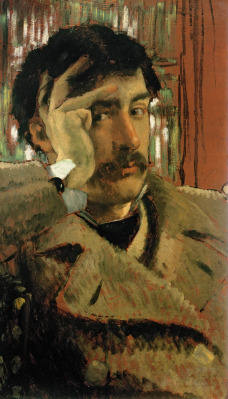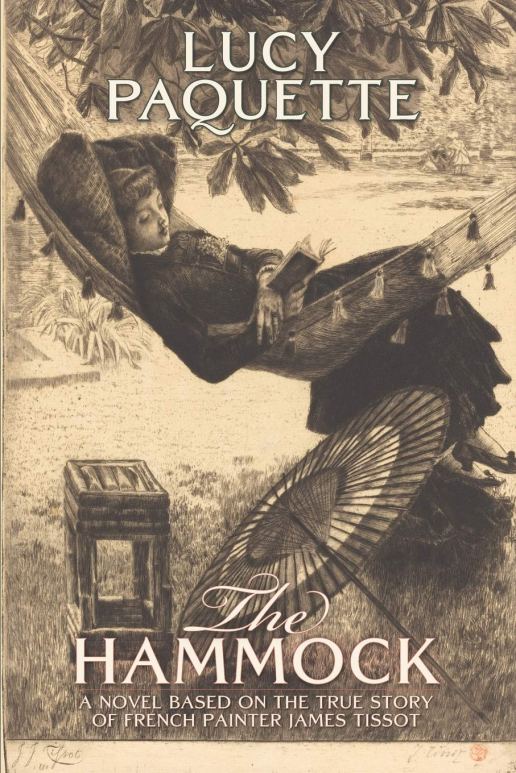To cite this article: Paquette, Lucy. “Tissot’s Romances.” The Hammock. https://thehammocknovel.wordpress.com/2014/01/30/tissots-romances/. <Date viewed.>

Self portrait, c.1865 (oil on panel), by James Tissot.
Fine Arts Museums of San Francisco, CA, USA. Courtesy of The Bridgeman Art Library for use in “The Hammock: A novel based on the true story of French painter James Tissot” by Lucy Paquette, © 2012.
James Tissot, a handsome and successful man described by one biographer as a “skirt chaser,” remained single all his life; his attempts to marry were foiled.
In Paris in his early thirties, he must have been engaged after building an opulent home in the fashionable avenue de l’Impératrice (now avenue Foch), but he fled to London following the Franco-Prussian War and its bloody aftermath, the Commune.
His friend Edgar Degas wrote to him on September 30, 1871: “And what about the marriage?”
Tissot was busy, earning a great deal of money after having arrived in London with only one hundred francs in his pocket, and his old friends had not heard from him.
One of them, Jules Ferdinand Jacquemart* (1837 – 1880), was worried about Tissot, though the artist had friends in London.
It seems that war and civil rebellion had drastically altered Tissot’s life and ruined his plans to wed.
Within a few years, he bought the leasehold to a house in St. John’s Wood, at 17 (now 44) Grove End Road, and built an extension with a studio and a conservatory (designed by architect J.M. Brydon, and featured in The Building News in 1874). British painter Louise Jopling’s lovely blonde sister, Alice, attracted Tissot’s interest. Louise (1843–1933) wrote of Tissot in her autobiography, “He admired my sister Alice very much, and he asked her to sit to him, in the pretty house in St. John’s Wood.” I believe the model for The Bunch of Lilacs was Alice: in this photograph of Louise and her sisters, look at the blonde on the left, in the back, and compare for yourself!

The Bunch of Lilacs (c. 1875), by James Tissot. Image courtesy of The Bridgeman Art Library for use in “The Hammock: A novel based on the true story of French painter James Tissot,” by Lucy Paquette © 2012
In London around 1875 or 1876, Tissot met Kathleen Newton (1854 – 1882), an Irish divorcée in her early twenties with a four-year-old daughter and a son born on March 21, 1876. [See Was Cecil Newton James Tissot’s son?]
Being Roman Catholic, Kathleen could not remarry, but she lived with Tissot in his house in St. John’s Wood, until her death from tuberculosis in 1882. [See James Tissot’s garden idyll & Kathleen Newton’s death]

Portrait of M.N. (Portrait of Mrs. Newton), 1876, etching and drypoint by James Tissot. (Photo: Wikipaintings.org)
Upon Kathleen’s death, Tissot returned to his house in Paris and attempted to revive his career there. In 1885, he briefly was infatuated with a tightrope dancer who also was being pursued by the author and journalist Aurélien Scholl (1833 – 1902), and whom Tissot had painted as L’Acrobate (The Tightrope Dancer, c. 1883-85, whereabouts unknown) in his La Femme à Paris series. (Each of the fifteen paintings in this series was to have a story written about it, and interestingly, L’Acrobate was assigned to Aurélien Scholl.)
The same year, Tissot planned to marry Louise Riesener (1860 – 1944), the granddaughter of portrait painter Henri Riesener (1767 – 1828), a daughter of the painter Léon Riesener (1808-1878), and a cousin of painter Eugène Delacroix (1798 – 1863). Along with her sister Rosalie, she belonged to the same artistic social set as Berthe Morisot, for whom they modeled. Louise also was a friend and student of the painter Henri Fantin-Latour (1836 – 1904), who portrayed her twice, in 1879 and 1880. Fantin’s La leçon de dessin (1879), now at the Musées royaux des beaux-arts de Belgique in Brussels, depicts the blonde Louise’s pursuit of her artistic ambitions; she is shown with her dark-haired friend, Emma Callimachi-Catargi, during a lesson in Fantin-Latour’s studio. Fantin-Latour painted Mademoiselle Riesener in an 1880 portrait now at the Musée d’Orsay. Berthe Morisot painted a portrait in oil, now at the Musée Marmottan Monet, París, of her friend Louise Riesener in 1881. [Morisot’s 1888 charcoal and pastel portrait of Louise is now in the collection of the Cleveland Museum of Art but not currently on view, and Morisot’s 1888 oil portrait of Louise is at the Musée d’Orsay.]

Study for ‘Le sphinx’ (Woman in an Interior), by James Tissot. Oil on panel, 44 by 27 in. (111.76 by 68.58 cm). Private Collection. (Photo: Wikimedia.org)
The match between James Tissot and Louise Riesener was arranged by the wife of Tissot’s longtime friend, the novelist Alphonse Daudet (1840 – 1897). Tissot had painted Mademoiselle Riesener, described as “une fille déja d’un certain âge,” as Le Sphinx (c. 1883-85, whereabouts unknown) in his La Femme à Paris series. Le Sphinx portrays an aloof woman seated on a sofa in a comfortable house, with a man’s top hat and stick on a nearby chair. Tissot built a new floor on his house in preparation for his married life with Louise. Unfortunately, one day when Tissot removed his overcoat in the front hall, his appearance struck his twenty-five-year-old fiancée as old-fashioned. Louise** suddenly decided that she had lost her desire to marry. Tissot was forty-nine.
He tried to contact Kathleen Newton through a series of séances. On May 20, 1885, at a séance in London, Tissot recognized the female of two spirits who appeared as Kathleen, and he asked her to kiss him. The spirit is said to have done so, several times, with “lips of fire.” Then she shook hands with Tissot and disappeared. He made this image of the vision to commemorate their reunion.

L’Apparition médiunimique (The Apparition, 1885), by James Tissot. Mezzotint, Private Collection. (Photo: Wikipaintings.org)
For more information on Jacquemart*, see James Tissot and The Artists’ Brigade, 1870-71.
Louise Riesener** later married Claude Léouzon-le-Duc (1860 – 1932), a lawyer and politician exactly her age.
© 2014 by Lucy Paquette. All rights reserved.
The articles published on this blog are copyrighted by Lucy Paquette. An article or any portion of it may not be reproduced in any medium or transmitted in any form, electronic or mechanical, without the author’s permission. You are welcome to cite or quote from an article provided you give full acknowledgement to the author.
Related blog posts:
The high life, 1868: Tissot, his villa & The Circle of the Rue Royale
Tissot’s La Femme à Paris series
Kathleen Newton by James Tissot: eight auctioned oil paintings
 If you do not have a Kindle e-reader, you may download free Kindle reading apps for PCs, Smartphones, tablets, and the Kindle Cloud Reader to read The Hammock: A novel based on the true story of French painter James Tissot. Read reviews.
If you do not have a Kindle e-reader, you may download free Kindle reading apps for PCs, Smartphones, tablets, and the Kindle Cloud Reader to read The Hammock: A novel based on the true story of French painter James Tissot. Read reviews.
The Hammock: A novel based on the true story of French painter James Tissot, brings Tissot’s world from 1870 to 1879 alive in a story of war, art, Society glamour, love, scandal, and tragedy.
Illustrated with 17 stunning, high-resolution fine art images in full color
Courtesy of The Bridgeman Art Library
(295 pages; ISBN (ePub): 978-0-615-68267-9). See http://www.amazon.com/dp/B009P5RYVE.
The Hammock: A novel based on the true story of French painter James Tissot is now available as a print book – a paperback edition with an elegant and distinctive cover by the New York-based graphic designer for television and film, Emilie Misset.
